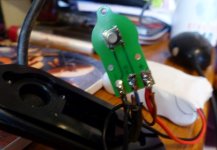ChrisSharman
New member
My trusty Viper has packed in - no longer switches on or off. 
The cable insulation has worn through near the battery, and the brown & blue wires snapped off the switch.
I've shortened the blue wire (which seemed to have suffered where the insulation had worn through), and resoldered blue to the other side of the switch and brown to red.
Seems to charge ok (goes to green light), and the blue flashing indicator registers when the battery's connected to the lamp, but still won't switch on or off.
Switch feels positive, has no visible damage. Picture attached, hopefully.
Any suggestions please?
Thanks, Chris
The cable insulation has worn through near the battery, and the brown & blue wires snapped off the switch.
I've shortened the blue wire (which seemed to have suffered where the insulation had worn through), and resoldered blue to the other side of the switch and brown to red.
Seems to charge ok (goes to green light), and the blue flashing indicator registers when the battery's connected to the lamp, but still won't switch on or off.
Switch feels positive, has no visible damage. Picture attached, hopefully.
Any suggestions please?
Thanks, Chris




